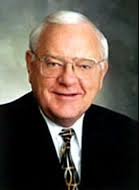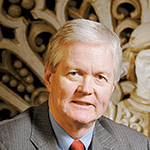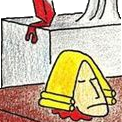Ryan v. U.S. ⸻ Story │ Record │ Discussion










How Frank Easterbrook Kept George Ryan in Prison
In July 2016, the Valparaiso University Law Review published an extraordinary/notorious/blockbuster article (styled a “Memoir”), written by a respected professor of law, Albert Alschuler,α telling the story of how a “renowned” (though perhaps not necessarily “respected”) judge, Frank Easterbrook of the 7th Federal Cir. Court of Appeals (and, incidentally, a colleague of Alschuler’s at U. Chicago), committed Judicial Misconduct from the bench, with the biased/illicit/illegal goal of keeping George Ryan (former governor of Illinois) in prison. (The nature of the civil/appellate action, based upon 28 USC §2255, was to vacate part of — namely, the part about the “honest services” clause, 18 USC §1346, of the mail fraud statute which was later invalidated by the case of Skilling v. U.S., and hence the RICO charges predicated upon it — Ryan’s prior criminal conviction/sentence; Alschuler was Ryan’s lead appellate attorney.)
α・ Prof. Alschuler’s academic credentials can be found online (University of Chicago ⌥; Northwestern University ⌥). As a broad-brush generalization, it can be said that Alschuler’s academic/professional interest/expertise lies in the direction of post-conviction criminal law, as evinced in the Ryan v. U.S. case analyzed in this place; see also, for example, his Amicus Curiae briefs, filed in the cases of Weyhrauch v. U.S. ⌥, and of Class v. U.S. ⌥.
Publication of the Memoir amounted to a “scandalous”/“tell-all” exposé, breaking the legal profession’s “code of silence” (but upholding its “code of ethics”!) regarding corrupt/criminal judges who commit obstruction of justice. The combination of the Memoir’s impeccable provenance from an unimpeachable source (knowledgeable/academic, not “mere/emotional sour grapes”), excruciating detail (fully documented), masterful presentation, and the fact that all the Memoir’s claims of Judicial Misconduct had already been made previously in legal briefs/petitions to the Appellate/Supreme courts reviewing the Ryan v. U.S. matter (but ignored by those courts), caused a major convulsion, reverberating throughout the American legal establishment (which unfortunately, though unrebutted to date, has not yet led to measurable reform in the judicial system [though that process has now been started, via Judicial Misconduct proceedings, see infra]):
- Wikipedia ⌥.
- George Ryan Gallery ⌥.
- Chicago Tribune, extensive list of articles about George Ryan.
- Announcement of Indictment ⌥. Dec 17 2003.
- Univ. Chicago Law Faculty Blog ⌥. Oct 12 2005.
- Chicago Tribune, Ryan Pro Bono Problem ⌥. Jul 19 2006.
- Greenbag ⌥. Winter 2006.
- NPR ⌥. Nov 6 2007.
- New York Times ⌥. Nov 8 2007.
- George Ryan, Nobel Peace Prize Nomination ⌥. 2011.
- Yale Journal on Regulation, Easterbrook Edition ⌥. Oct 10 2015.
- Yale Journal on Regulation, Easterbrook Edition, Redux ⌥. Jul 20 2016.
- CrimProf Blog ⌥. Jul 21 2016.
- Legal Ethics Forum ⌥. Jul 21 2016.
- Crain’s Chicago Business ⌥. Jul 25 2016.
- Chicago Daily Law Bulletin ⌥. Jul 25 2016.
- ABA Journal ⌥. Jul 28 2016.
- DC Circuit Review ⌥. Jul 30 2016.
- Daily Journal ⌥. Aug 6 2016.
- Justia Verdict ⌥. Aug 25 2016.
- Albuquerque Journal ⌥. Sep 19 2016.
- Injustice Watch 1 ⌥, Apr 4 2017; Injustice Watch 2 ⌥, Apr 10 2017.
The case of Ryan v. U.S. (a.k.a. “Alschuler v. Easterbrook”) represents, rather certainly, the leading instance/object-lesson of Judicial Misconduct on recordβ (though it wasn’t formally/officially prosecuted as a case of Judicial Misconduct per se — until now, see infra). Alschuler’s Memoir “speaks for itself,” is exhaustive, and cannot be bettered.γ For that reason, we do no more in this place than offer a convenient repository for case documents, advertising/facilitating/urging readers to study this case.
β・ Perhaps the most notable previous fusillade, by professor Anthony D’Amato ⌥, also targeted Judge Easterbrook: (i) Chicago Tribune, John Branion Story ⌥; (ii) Illinois v. Branion (1970) ⌥; (iii) Branion v. Gramly, 855 F.2d 1256 (7th Cir 1988) ⌥; (iv) Chicago Tribune (1988) ⌥; (v) New York Times (1989) ⌥; (vi) 11 Cardozo L. Rev. 1313 (Jul/Aug 1990) ⌥; (vii) 26 U. C. Davis L. Rev. ℘527–582 (1992–93) ⌥.
γ・ Well, there is one minor sense in which this case may be considered “deficient” (if that’s the best term), namely, it’s a “lawyer’s case,” that is, it’s full of low-level technical/legalistic twists-and-turns, that only a lawyer can fully appreciate (Alschuler himself admits as much, in his Memoir at ℘19). By contrast, Tuvell v. IBM is a high-level model of layperson-friendly simplicity, hence more suitable as a “perfect test-case” of Judicial Misconduct. The dates given in the following list are end-dates (for example, end-of-trial).
- How Frank Easterbrook Kept George Ryan in Prison (VULR ʋ50 İ1 ℘7–87) ⌥ ⌥ (2015; published online Jul 20 2016). ➔ The Memoir, “Mem.”
- Memoir, Annotated, “MemAnn”{PdfAnn} (an “amazing ‘exegesis,’” keying off of Easterbrook’s usage of that word, in his First Opinion at ℘8). May 9 2018. ☛KEY☚
- A much earlier article by Alschuler (testifying to his long-term interest/expertise in courtroom official misconduct): Courtroom Misconduct by Prosecutors and Trial Judges ⌥, Texas Law Review, ʋ50 №4. Apr 1972.
- U.S. v. Ryan, Indictment, Second Superseding. Apr 2002 Special Grand Jury.
- U.S. v. Warner (& Ryan), Jury Instructions (Pallmeyer). Mar 10 2006.
- Trial and conviction. Sep 18 2006.
- U.S. v. Warner (& Ryan), 498 F.3d 666 ⌥, appeal, denied (Manion, Kanne, Wood). Aug 21 2007.
- U.S. v. Warner (& Ryan), 506 F.3d 517 ⌥ ⌥, petition for rehearing, denied (Easterbrook, Ripple, Manion, Wood, Evans, Sykes; Posner, Kanne, Williams dissenting). Oct 24 2007.
- Ryan v. Board of Trustees (forfeit of pension benefits) ⌥. Feb 19 2010.
- Skilling v. U.S.; 561 US, https://www.supremecourt.gov/opinions/boundvolumes/561BV.pdf ℘403–520 ⌥. Jun 24 2010.
- Weyhrauch v. U.S., 561 US ⌥. Jun 24 2010.
- Ryan v. U.S., Court of Appeals Docket. Dec 28 2010 – Aug 6 2016.
- Ryan v. U.S., District Court Record. January 5, 2011.
- Includes post-conviction Petition, Motion (in District Court) and Memorandum of Law, to Vacate, Set Aside or Correct Ryan’s sentence pursuant to 28 USC §2255, and related documents. Aug 31 2010.
- Includes District Judge’s (Pallmeyer) Ruling, denying Motion to Vacate, Set Aside, or Correct Ryan’s sentence (a.k.a. 759 F.Supp.2d 975 (N.D. Ill. 2010)). Dec 21 2010.
- Ryan v. U.S., Appellant Brief. Feb 11 2011.
- Ryan v. U.S., Appellant Separate Appendix (Vol. 1 & 2). Feb 11 2011.
- Includes original of Second Superseding Indictment. Apr 2002.
- Ryan v. U.S., Appellant Separate Appendix (Vol. 1 & 2). Feb 11 2011.
- Ryan v. U.S., Appellee Brief. Mar 15 2011.
- Ryan v. U.S., Appellant Reply Brief. Mar 28 2011.
- Appellant Additional Authority. May 24 2011.
- Ryan v. U.S., Oral Argument, audio ⌥. May 31 2011.
- Ryan v. U.S., Appellant Post-Argument Supplemental Memorandum. Jun 14 2011.
- Appellant Post-Argument Supplemental Appendix. Jul 19 2011.
- Ryan v. U.S., Appellee Post-Argument Supplemental Memorandum. Jun 14 2011.
- Ryan v. U.S., Opinion/Decision, 645 F.3d 913 (7th Cir, later vacated and remanded) ⌥ (Easterbrook, Wood, Tinder) — “Easterbrook’s First Opinion.” Jul 6 2011.
- Ryan v. U.S., Petition for Rehearing (2011). Jul 19 2011.
- Ryan v. U.S., Petition For Writ of Certiorari (№11-499) ⌥. Oct 19 2011.
- Pet Writ Cert Appendix. Oct 19 2011.
- Ryan v. U.S., Pet Writ Cert Opposition ⌥. Dec 2011.
- Ryan v. U.S., Reply to Pet Writ Cert Opposition ⌥. Dec 30 2011.
- Ryan v. U.S., Opinion/Decision (GVR, Grant/Vacate/Remand), 132 S.Ct. 2099 ⌥ ⌥ ⌥ ⌥ ⌥. Apr 30 2012 (or Apr 29, according to some sources).
- Ryan v. U.S., Appellant Position Statement. Jun 22 2012.
- Ryan v. U.S., Appellant’s Rule 54 Statement. Jun 22 2012.
- Ryan v. U.S., Appellee Position Statement. Jun 22 2012.
- Ryan v. U.S., Oral Argument (2012), audio ⌥ Jul 20 2012.
- Transcript ¬N/A⌐.
- Ryan v. U S., Opinion/Decision, 688 F.3d 845 (7th Cir 2012) ⌥ ⌥ (Easterbrook, Wood, Tinder) — “Easterbrook’s Second Opinion.” Aug 6 2012.
- Ryan v. U.S., Petition for Rehearing (2012). Sep 7 2012.
Complaint(s) of Judicial Misconduct
On Jul 13 2017, a Complaint of Judicial Misconduct against Easterbrook was formally filed with the Seventh Circuit Judicial Council (see the 7th Cir. Judicial Misconduct webpage), based on Alschuler’s Memoir (in conjunction with this website).δ
δ・ Note that anybody has “standing” to file a Judicial Misconduct Complaint, against any Federal judge (regardless of jurisdiction or any other consideration, such as statute of limitations, JCDR 9): “A complaint … is filed by any person in his or her individual capacity or on behalf of a professional organization …” (JCDR 3(c)(i)). The only significant “Catch-22” is that a complaint will be dismissed pro forma if the judge is not currently in service (see JCDR 4); this is how Judge Alex Kozinski “beat the rap” against him (for sexual misconduct): he resigned immediately after the complaint against him had been filed, but before it could be reviewed/processed (Accusation ⌥; Ninth Circuit Order ⌥; Reassignment ⌥; Supreme Court Transfer Order ⌥; Inaction ⌥; Dismissal ⌥; Dismissal Order ⌥; Judicial Conference Referral).
More than 7 months later, the Judicial Council still(!) hadn’t acknowledged the receipt/filing of the Complaint, even though the Complaint had indeed been delivered (provably so, according to the U.S. Post Office’s Proof of Service), and acknowledgement of receipt by the court clerk is required by law/rule, JCDR 8(a). Thereby, the clerk violated, not only (i) JCDR 8(a) (by failing to notify Complainant of receipt of the Complaint), but also (ii) statutory law 28 USC §351(c) (by failing to notify the judges of receipt of Complaint). That being the case, Complainant phoned the clerk’s office on Feb 27 2018 to check on the status of his Complaint, and recorded itε (audio, albeit rather low quality; transcript). The clerk (who refused to identify herself(!), or to transfer the call to her supervisor(!)) falsely denied the Complaint had been received! Instead, she “suggested” that Complainant re-submit the Complaint. So Complainant complied, re-submitting the Complaint on Feb 28 2018 (Proof of Service #2).
ε・ Recording one’s oral communications with others, including telephone conversations, is “historically generally frowned upon,” and there are many laws regulating it — though it’s not as bad as third-party covert (“0-party consent”) “wiretapping” interception (Federal Wiretap Act (a.k.a, Title III of the Electronic Communications and Privacy Act, ECPA), 18 USC §2510–2522, esp. §2511; and the Congressional Research Service Report on Electronic Privacy ⌥). There are exceptions to the laws, however, and times are changing. For example, some courts have held that such recordings are illegal only if accompanied by the intent to use the illicit recording to commit a tort of crime beyond the act of recording itself (⌥ ⌥ ⌥). In particular, when self-recordings are made “in anticipation/expectation/purposes of uncovering/gathering/preserving evidence of illegal activity” (such as the illegally unprocessed filing) — and especially if the target of investigation is government officials conducting the usual course of their official duties, interacting with the public — then “all bets are off.”† And that was indeed the case here. The tactic succeeded: at the 09:02 mark of the transcript, the clerk voluntarily admitted that the Seventh Circuit clerk’s office, as part of its standard practice, secretly (without publishing notice of the practice, which is certainly a requirement,‡ and even more certainly so for pro se “customers”), consciously/knowingly/actively refuses to acknowledge receipt of complaint, and instead passively forces the Complainant to call the clerk’s office for confirmation of receipt. Thereby breaking the law/rule JCDR 8(a) (emphasis added): “Upon receiving a complaint against a judge …, the circuit clerk must open a file, assign a docket number according to a uniform numbering scheme promulgated by the Committee on Judicial Conduct and Disability, and acknowledge the complaint’s receipt.” {†・In this case (gathering evidence of crime), in addition to many jurisdictions having statutes legalizing recordings, the equities (“spirit/habit of fairness/justness/right-dealing which regulates intercourse amongst people” — Black’s Law Dictionary, 2nd ed., paraphrased; the “third leg of the law,” after statutory/legislated and common/court-made) are super-strongly in your favor. No prosecutor will prosecute, no jury will convict, no judge will uphold. Think 60 Minutes. Analogy: it’s OK to jaywalk if that’s what it takes to prevent a robbery. References: Digital Media Law Project (DMLP), Recording Phone Calls and Conversations ⌥ (noting the federal single-party-consent rule/law, 18 USC 2511(2)(d), this being a federal case), Recording Police Officers and Public Officials ⌥; Citizens’s Right to Monitor Government Officials, ⌥. Cases: Overturning Insane Recording Laws 1 ⌥ ⌥, Overturning Insane Recording Laws 2 ⌥, Overturning Insane Recording Laws 3 ⌥ (plus many more to come, such as this one ⌥ ⌥).} {‡・See Murphy, The Duty of the Government to Make the Law Known, Fordham Law Review, ʋ51 İ2 Å2 (1982) ⌥. See also the present writer’s essay on the Promulgation Clause, in his Petition for Rehearing to the Supreme Court.}
A month later, on Mar 28 2018, the Judicial Council finally did (i) acknowledge receipt of the (re-submitted) Easterbrook Complaint, and (ii) assigned it a case number (№07-18-90014), and simultaneously (iii) dismissed the Complaint.ζ
ζ・ Not surprisingly (given the general perfidy of the Seventh Circuit, as seen in the Ryan v. U.S. case reviewed here), that Dismissal falsely cited the date of the Complaint’s filing as Mar 7 2018; but that reflected the second filing date (actually, timestamped Feb 28 2018), instead of the correct first filing date of Jul 13 2017, as noted supra.
Judicial Council Review(s)
And so, in what had become by now a sadly familiar ritual (see Tuvell v. IBM Judicial Council Review), two responses were now in order (filed on May 9 2018, delivered on May 14 2018):
- Petition for Review of the Easterbrook Complaint.
- The really big contribution included here was the “amazing ‘exegesis’,” MemAnn, mentioned above.
- A new Complaint of Judicial Misconduct, this one against Judge Wood.
- (Both of these were accompanied with an annotated version of Wood’s dismissal of the Easterbrook Complaint, and a Notice of Website and Annotated Memoir.)
BUT … on May 14 2018, the Judicial Council rejected (refused to accept/file) the Petition for Review (of the Easterbrook Complaint), on the basis of (alleged) untimeliness: Rejection Letter (of Easterbrook Complaint).
“Normally,” one would think an out-of-time submission (as alleged here) would automatically be final/fatal, without recourse. But, this was not exactly a “normal" case. And so, this led to the next step: Judicial Conference Proceedings, infra (again paralleling Tuvell v. IBM Judicial Conference Review).
AND THEN … on May 18 2018, the Judicial Council (i) acknowledged receipt of the Wood Complaint, (ii) assigned it a case number (№07-18-90037), and simultaneously (iii) dismissed the Complaint.η
η・ The dismissal of the Wood Complaint was written by Judge Easterbrook himself! This was “more than a little curious,“ for two reasons: (i) Judge Easterbrook should have recused himself, because … obviously. (Easterbrook judging Wood judging Easterbrook⁇ Oh Come On, that's clear conflict-of-interest, calling for disqualification/recusal.) (ii) On a Complaint of Judicial Misconduct against the Chief Judge (in this case, Wood), a “designated acting chief judge” must be chosen/appointed for the “initial review of the Complaint by the (nominal-)‘chief judge’” (JCDR 25(f)) The order-of-choice for this appointment proceeds through the list of active-status judges, in descending order of seniority. In the present case, there were more-senior judges between Wood and Easterbrook: William J. Bauer (ineligible, because “senior-status,” hence not “active-status”), and Joel M. Flaum. So, Flaum “should” have reviewed the Wood Complaint. But he didn’t, deferring instead to Easterbrook. The “curious” thing about this is that, such kind of “irregularity” (non-algorithmic, preferential) in appointment/selection of judges to cases is precisely one of the bad-faith activities in the Seventh Circuit that Alschuler complains about in his Memoir (c. ℘38ƒ156)!
On Jun 21 2018, Petition for Review of the Wood Complaint was filed (with Annotated version of the Dismissal Order) ⌥ ⌥.θ It was, of course, denied on Aug 14. Without substantive opinion/comment, of course (i.e., typical continued cover-up).
θ・ This legally processed proof-of-receipt for the Jun 21 2018 filing is especially interesting, because it’s signed with the same signature as the illegally unprocessed proof-of-receipt for the Jul 13 2017 filing (but different than the signature on the legally processed proof-of-receipt for the Feb 28 2018 filing). Hmm, inquiring minds want to know just who this illegally-nonprocessing signature belongs to ?…
Judicial Conference Proceedings
On May 28 2018, Petition for Review by the Judicial Conference (of Easterbrook Complaint) was filed ⌥ ⌥ ⌥ ⌥ ⌥ ⌥ ⌥.
On Aug 29 2018, Petition for Review by the Judicial Conference (of Wood Complaint) was filed ⌥ ⌥ ⌥.
⌘TBD⌘
